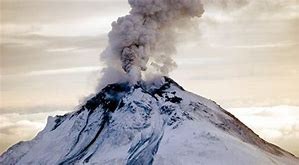Before fifty million years ago, Earth had no regular ice ages, but when we did have them they tended to be colossal. A massive freezing occurred about 2.2 billion years ago, followed by a billion years or so of warmth. Then there was another ice age even larger than the first— so large that some scientists are now referring to the age in which it occurred as the Cryogenian, or super ice age. The condition is more popularly known as Snowball Earth.
在5000萬(wàn)年前,地球上并沒有很有規(guī)律的冰川期,可是一當(dāng)它們?cè)诘厍蛏铣霈F(xiàn),其規(guī)模和持續(xù)時(shí)間都是十分驚人的。第一次大范圍的冰川期出現(xiàn)在大約22億年前,之后就是長(zhǎng)達(dá)10億年左右的溫暖期。在這之后出現(xiàn)的冰川期比第一次來(lái)得更大——事實(shí)上,它是如此之大,以至于如今有些科學(xué)家提到那個(gè)時(shí)代時(shí),都用上了覆冰紀(jì)或超級(jí)冰川期這樣的字眼。這種狀況更經(jīng)常被稱為“雪球世界”。
"Snowball," however, barely captures the murderousness of conditions. The theory is that because of a fall in solar radiation of about 6 percent and a dropoff in the production (or retention) of greenhouse gases, Earth essentially lost its ability to hold on to its heat. It became a kind of all-over Antarctica. Temperatures plunged by as much as 80 degrees Fahrenheit. The entire surface of the planet may have frozen solid, with ocean ice up to half a mile thick at higher latitudes and tens of yards thick even in the tropics.
然而,“ 雪球”很難說(shuō)明那一時(shí)期環(huán)境極其惡劣的程度。那種理論認(rèn)為。由于陽(yáng)光的照射量減少了約6%,產(chǎn)生(或保留)溫室氣體的能力降低,地球?qū)嶋H上堆以保持其熱量。地球變成了如同南極那樣的冰天雪地,氣溫降低了45攝氏度。整個(gè)地球表面都被凍得嚴(yán)嚴(yán)實(shí)實(shí),高緯度地區(qū)的海洋結(jié)冰厚達(dá)800米,熱帶地區(qū)的也有幾十米厚。
There is a serious problem in all this in that the geological evidence indicates ice everywhere, including around the equator, while the biological evidence suggests just as firmly that there must have been open water somewhere. For one thing, cyanobacteria survived the experience, and they photosynthesize. For that they needed sunlight, but as you will know if you have ever tried to peer through it, ice quickly becomes opaque and after only a few yards would pass on no light at all. Two possibilities have been suggested. One is that a little ocean water did remain exposed (perhaps because of some kind of localized warming at a hot spot); the other is that maybe the ice formed in such a way that it remained translucent— a condition that does sometimes happen in nature.
這里存在一個(gè)嚴(yán)重問題:從地質(zhì)學(xué)角度來(lái)看,整個(gè)地球,包括赤道地區(qū)在內(nèi),都被冰雪所覆蓋;可是從生物學(xué)角度來(lái)看,卻又確定無(wú)誤地表明在某些地方一定存在著未曾冰凍的水域。首先,藻青菌存活了下來(lái),還進(jìn)行了光合作用。進(jìn)行光合作用需要陽(yáng)光,可是要是你透過冰塊看,你會(huì)發(fā)現(xiàn)光線很快變得越來(lái)越暗,幾米之外就根本看不見光線了。對(duì)于這個(gè)問題,可能有兩種解釋:一是有一小部分水域確實(shí)未曾冰凍(也許是因?yàn)楫?dāng)?shù)啬硞€(gè)地方很熱);一是某些結(jié)構(gòu)的冰塊是半透明的這種現(xiàn)輔時(shí)在大自然中確實(shí)存在。
 If Earth did freeze over, then there is the very difficult question of how it ever got warm again. An icy planet should reflect so much heat that it would stay frozen forever. It appears that rescue may have come from our molten interior. Once again, we may be indebted to tectonics for allowing us to be here. The idea is that we were saved by volcanoes, which pushed through the buried surface, pumping out lots of heat and gases that melted the snows and re-formed the atmosphere. Interestingly, the end of this hyper-frigid episode is marked by the Cambrian outburst—the springtime event of life's history. In fact, it may not have been as tranquil as all that. As Earth warmed, it probably had the wildest weather it has ever experienced, with hurricanes powerful enough to raise waves to the heights of skyscrapers and rainfalls of indescribable intensity.
If Earth did freeze over, then there is the very difficult question of how it ever got warm again. An icy planet should reflect so much heat that it would stay frozen forever. It appears that rescue may have come from our molten interior. Once again, we may be indebted to tectonics for allowing us to be here. The idea is that we were saved by volcanoes, which pushed through the buried surface, pumping out lots of heat and gases that melted the snows and re-formed the atmosphere. Interestingly, the end of this hyper-frigid episode is marked by the Cambrian outburst—the springtime event of life's history. In fact, it may not have been as tranquil as all that. As Earth warmed, it probably had the wildest weather it has ever experienced, with hurricanes powerful enough to raise waves to the heights of skyscrapers and rainfalls of indescribable intensity.
如果地球確實(shí)被冰凍過,那它又是怎樣重新變得溫暖起來(lái)的呢?這是一個(gè)很難于回答的問題。由于反射的熱量太多,一個(gè)處于冰凍狀態(tài)的星球會(huì)永遠(yuǎn)保持這種狀態(tài)。挽救這種局面的力量似乎來(lái)自地球內(nèi)部的巖漿。我們能在這里也許要再次感謝地殼的構(gòu)造。我們認(rèn)為,是火山救了我們。火山的噴發(fā)突破了冰川的封鎖,噴涌而出的熱量和氣體融化了地表的冰雪,使得大氣層重新得以改變。非常有意思的是,這一次高度寒冷的時(shí)期是以寒武紀(jì)大爆發(fā)——生命發(fā)展史上的春天——為結(jié)束的標(biāo)志。當(dāng)然,這樣一個(gè)春天并非總是風(fēng)和日麗,因?yàn)殡S著地球變暖。它經(jīng)歷了有史以來(lái)最狂暴的天氣,強(qiáng)烈的颶風(fēng)掀起摩天大樓高的巨浪,到處下著不可思議的瓢潑大雨。
 If Earth did freeze over, then there is the very difficult question of how it ever got warm again. An icy planet should reflect so much heat that it would stay frozen forever. It appears that rescue may have come from our molten interior. Once again, we may be indebted to tectonics for allowing us to be here. The idea is that we were saved by volcanoes, which pushed through the buried surface, pumping out lots of heat and gases that melted the snows and re-formed the atmosphere. Interestingly, the end of this hyper-frigid episode is marked by the Cambrian outburst—the springtime event of life's history. In fact, it may not have been as tranquil as all that. As Earth warmed, it probably had the wildest weather it has ever experienced, with hurricanes powerful enough to raise waves to the heights of skyscrapers and rainfalls of indescribable intensity.
If Earth did freeze over, then there is the very difficult question of how it ever got warm again. An icy planet should reflect so much heat that it would stay frozen forever. It appears that rescue may have come from our molten interior. Once again, we may be indebted to tectonics for allowing us to be here. The idea is that we were saved by volcanoes, which pushed through the buried surface, pumping out lots of heat and gases that melted the snows and re-formed the atmosphere. Interestingly, the end of this hyper-frigid episode is marked by the Cambrian outburst—the springtime event of life's history. In fact, it may not have been as tranquil as all that. As Earth warmed, it probably had the wildest weather it has ever experienced, with hurricanes powerful enough to raise waves to the heights of skyscrapers and rainfalls of indescribable intensity.










